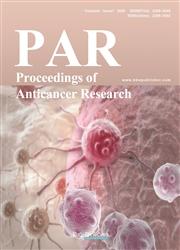Role of CST1 in Promoting Gastric Cancer Metastasis and Analysis of Its Mechanism
引用次数: 0
Abstract
Objective: To elucidate the role and mechanism of cysteine protease inhibitor SN (CST1) in promoting the metastasis of gastric cancer. Methods: (1) Firstly, 6 pairs of cancer and paracancer tissue samples from gastric cancer patients without distant metastasis and 5 pairs of cancer and paracancer tissue samples from gastric cancer patients with peritoneal metastasis were collected for transcriptome sequencing. Statistical analysis was performed on the sequencing results to identify significantly upregulated differential genes. (2) Another 75 pairs of cancer and paracancer tissue samples were collected from gastric cancer patients, and the protein and total RNA of gastric cancer tissue samples were extracted. Western blot and quantitative reverse transcription polymerase chain reaction (qRT-PCR) were used to detect the expression of CST1 protein and messenger RNA (mRNA) in gastric cancer and adjacent tissues. (3) The total protein and total RNA of AGS, BGC823, HGC-27, MGC803, MKN45, SGC7901, and SNU-1 gastric cancer cells and normal gastric mucosal epithelial cells GES-1 were extracted. Western blot and qRT-PCR were used to detect CST1 protein and mRNA expression. Results: (1) The significantly upregulated differential gene CST1 was screened, and the expression of CST1 in gastric cancer tissues was significantly higher than that in adjacent tissues. (2) Compared with normal gastric mucosal epithelial cells GES-1, the expression of CST1 in gastric cancer cell lines was upregulated, and the expression of CST1 in HGC-27 and SNU-1 was relatively low, while the expression of CST1 in AGS and MKN45 was relatively high. At the same time, a stable cell line of HGC-27 overexpressing CST1 and MKN45 knocking down CST1 was successfully constructed. (3) Overexpression or knockdown of CST1 did not significantly change the proliferation ability of gastric cancer cells, but can promote the migration and invasion of gastric cancer cells. (4) CST1 may promote the metastasis of gastric cancer cells by activating the epithelial–mesenchymal transition (EMT) signaling pathway. Conclusion: CST1 gene promotes the migration of gastric cancer cells, and we found through animal experiments that CST1 can affect the metastasis and invasion function of gastric cancer and is negatively correlated with the level of E-cadherin.CST1在胃癌转移中的作用及其机制分析
目的:探讨半胱氨酸蛋白酶抑制剂SN(CST1)在促进癌症转移中的作用及其机制。方法:(1)首先采集6对无远处转移的癌症患者的癌症和癌旁组织样本和5对有腹膜转移的癌症患者的癌症和癌旁细胞组织样本进行转录组测序。对测序结果进行统计分析,以确定显著上调的差异基因。(2) 从癌症患者中采集75对癌症和癌旁组织样本,提取癌症组织样本的蛋白质和总RNA。采用蛋白质印迹和定量逆转录聚合酶链反应(qRT-PCR)方法检测癌症及癌旁组织中CST1蛋白和信使RNA(mRNA)的表达。(3) 提取AGS、BGC823、HGC-27、MGC803、MKN45、SGC7901和SNU-1胃癌症细胞和正常胃粘膜上皮细胞GES-1的总蛋白和总RNA。Western blot和qRT-PCR检测CST1蛋白和mRNA的表达。结果:(1)筛选到明显上调的差异基因CST1,其在癌症组织中的表达明显高于癌旁组织。(2) 与正常胃粘膜上皮细胞GES-1相比,CST1在癌症细胞系中的表达上调,并且CST1在HGC-27和SNU-1中的表达相对较低,而CST1在AGS和MKN45中的表达则相对较高。同时,成功构建了过表达CST1和MKN45敲除CST1的HGC-27稳定细胞系。(3) CST1的过表达或敲低对癌症细胞的增殖能力没有显著改变,但可促进癌症细胞的迁移和侵袭。(4) CST1可能通过激活上皮-间质转移(EMT)信号通路来促进癌症细胞的转移。结论:CST1基因促进了癌症细胞的迁移,通过动物实验发现,CST1可影响癌症的转移和侵袭功能,并与E-钙粘蛋白水平呈负相关。
本文章由计算机程序翻译,如有差异,请以英文原文为准。
求助全文
约1分钟内获得全文
求助全文

 求助内容:
求助内容: 应助结果提醒方式:
应助结果提醒方式:


